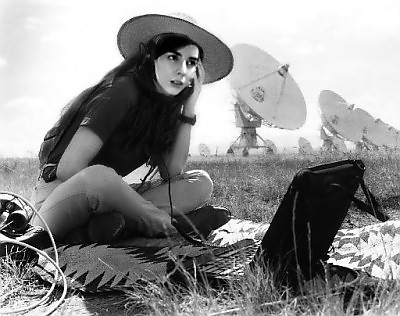This is not how I remember Contact....... Image credit: N. Ouellette.
Hi everyone! Welcome to the first (and maybe, but I hope not, last; please send me questions) edition of “Ask Nathalie” where you get to ask me random questions about astronomy, and I probably answer them! Nathalie is the person in the picture who hopes she doesn’t get sued by Jodie Foster, Carl Sagan’s living relative and whoever made the movie “Contact”. Also, I kind of hate the name “Ask Nathalie”, so please suggest other names. Alright, we have a triple header from a single reader, so here we go.
——————————–
Hi Nathalie!
1) Why does the Sun get hotter as you move outwards?
2) Which moon has a methane cycle?
3) If all the material in the asteroid belt were to combine, how big would this object be?
Cheers,
Knows Which Moon Has A Methane Cycle
——————————–
Dear Methane Cycle,
Yeah, that’s right. I’m also doing that thing where I’m giving the people who are writing in weird descriptive names. And yes, Methane Cycle, I really do believe you do actually know which moon has a methane cycle, because that sounds like an extremely pointed question for someone not in the know!!! Nevertheless, I will humour you and answer all your queries:
1) This isn’t quiiiiite true. On average, the hottest part of the sun is its core (about 15,000,000°C). As you move outwards from the core, the temperature drops until it reaches about 5,700°C at the surface, or photosphere. Temperature continues to drop once you enter the atmosphere, until you reach 500 km above the photosphere and hit the minimum temperature. Here, it’s a chilly 3,800°C. But then!… Now the weird stuff starts happening. A little higher up, you have the chromosphere that reaches 20,000°C. Further still is the corona where it’s 1,000,000°C to 2,000,000°C on average. Some hot spots can temporarily heat up to as high as 20,000,000°C, though! Toasty. Now why… Well, sadly we’re not sure (this column sucks!). In the Sun’s atmosphere, where it’s still very hot but the gravitational force is weaker, much of the gas is turned into plasma. And plasma is craaaaazy. By that I mean, of course, that it is heavily influenced by the Sun’s magnetic field. It may be that energy is transported from the cooler surface to the hotter corona (breaking the laws of thermodynamics, cringe) using a magnetic mechanism we don’t quite understand yet. So my advice to you is to become a physicist, figure this out and report back to me ASAP.
2) I think you already know this, but Saturn’s moon Titan has a methane cycle. By this, we simply mean it has a cycle very much like Earth’s water cycle (precipitation, evaporation, condensation, repeat), except with methane instead. The average temperature on Titan is about -180°C. Methane’s melting point is -182°C, and its boiling point is around -162°C. Oooh, look at that! That means Titan is covered in GIANT LAKES FILLED WITH COMBUSTIBLE FUEL. It’s thought that life may be harboured within these crazy fuel lakes, but if you’re interested in that topic, you should’ve asked that question specifically (aka send in this question).
3) It would be so easy for my to just answer “As big as your mama” here and call it a day, but I’m absolutely not that kind of a person. Instead, I will be extremely lazy and copy-paste the following from Wikipedia: “The total mass of the asteroid belt is estimated to be 2.8×10^21 to 3.2×10^21 kilograms, which is just 4% of the mass of the Moon”. I love you, Wikipedia.
SEND ME YOUR QUESTIONS!!!
Love,
Nathalie
P.S: OR ELSE.
